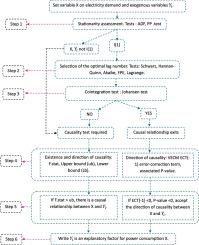选择电力消耗解释因素的计量经济学方法
IF 1.9
Q2 MULTIDISCIPLINARY SCIENCES
引用次数: 0
摘要
全面而仔细地选择输入是所有成功的能源需求模型的基础。然而,在大多数关于电力需求波动及其潜在决定因素的研究中,投入的选择往往是通过建立一种简单的相关性或对每一种所选投入的具体特征进行简短的描述性分析来确定的。因此,这项工作提出了一种新的输入选择方法,该方法基于平稳性检验、约翰松协整检验以及ARDL和VECM建模之间的相互作用,以促进在电力消耗建模中引入的输入之间的真正因果关系的突出。将这种新方法应用于喀麦隆的情况,可以确定人均国内总产值、二氧化碳排放量、城市化和用户数量与住宅用电量之间存在单向因果关系。因此,这些投入是解释该部门电力消耗的主要因素。•概述了在建模电力需求中选择输入变量的新方法。•将平稳性和约翰森检验以及ARDL和VECM模型相结合。•优化建模和预测电力需求的输入选择。本文章由计算机程序翻译,如有差异,请以英文原文为准。

Econometric methodology for selecting explanatory factors for power consumption
A thorough and careful choice of inputs is the bedrock of all successful energy demand modelling. However, the choice of inputs in most research into fluctuations in electricity demand and its potential determinants is very often made by establishing a simple correlation or by a short descriptive analysis of the specific characteristics of each selected input. As a result, this work proposes a new methodology for input selection based on the interaction between stationarity tests, the Johansen cointegration test, as well as ARDL and VECM modelling, in order to facilitate the highlighting of a real causal link between the inputs brought in the modelling of electricity consumption. Applying this new approach to the Cameroonian case, enables to establish the existence of a unidirectional causal relationship from GDP per capita, CO2 emissions, urbanization and the number of subscribers, respectively, to residential electricity consumption. These inputs are therefore the main factors explaining electricity consumption in this sector.
- •A new methodology for selecting input variables in modelling power demand is outlined.
- •The stationarity and Johansen tests as well as the ARDL and VECM models are combined.
- •The choice of inputs for modelling and forecasting power demand is optimized.
求助全文
通过发布文献求助,成功后即可免费获取论文全文。
去求助
来源期刊

MethodsX
Health Professions-Medical Laboratory Technology
CiteScore
3.60
自引率
5.30%
发文量
314
审稿时长
7 weeks
期刊介绍:
 求助内容:
求助内容: 应助结果提醒方式:
应助结果提醒方式:


